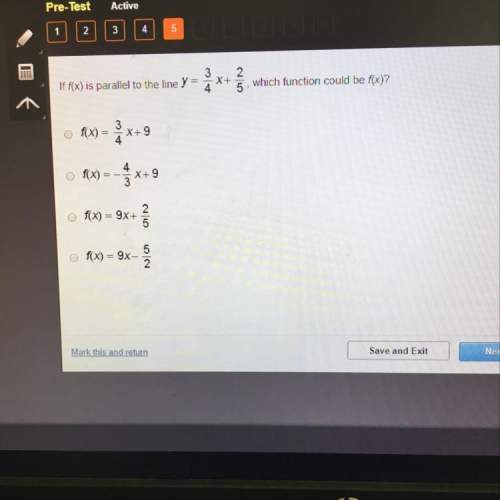
Mathematics, 20.09.2019 04:30 bella354
Let r(t)=⟨t2,1−t,4t⟩. calculate the derivative of r(t)⋅a(t) at t=5, assuming that a(5)=⟨−4,4,−5⟩ and a′(5)=⟨−5,9,3⟩

Answers: 1


Another question on Mathematics

Mathematics, 21.06.2019 18:00
Agraph of a trapezoid can have diagonals with slopes that are negative reciprocals and two pairs of adjacent sides that are congruent, true or false, and why
Answers: 1

Mathematics, 21.06.2019 20:00
Pepe and leo deposits money into their savings account at the end of the month the table shows the account balances. if there pattern of savings continue and neither earns interest nor withdraw any of the money , how will the balance compare after a very long time ?
Answers: 1

Mathematics, 21.06.2019 23:00
Joey is asked to name a quadrilateral that is also a rhombus and has 2 pairs of parallel sides.should be his answer
Answers: 1

Mathematics, 21.06.2019 23:30
Without multiplying, tell which product is larger and why. 5 × 1/3 or 5 × 2/3 a)5 × 1/3 because 1/3 is less than 2/3 b) 5 × 1/3 because 1/3 is greater than 2/3 c) 5 × 2/3 because 1/3 is less than 23 d) 5 × 23 because 1/3 is greater than 2/3
Answers: 1
You know the right answer?
Let r(t)=⟨t2,1−t,4t⟩. calculate the derivative of r(t)⋅a(t) at t=5, assuming that a(5)=⟨−4,4,−5⟩ and...
Questions

History, 30.07.2019 12:00


Mathematics, 30.07.2019 12:00

English, 30.07.2019 12:00




Mathematics, 30.07.2019 12:00


History, 30.07.2019 12:00


Mathematics, 30.07.2019 12:00


History, 30.07.2019 12:00

Geography, 30.07.2019 12:00





Biology, 30.07.2019 12:00










